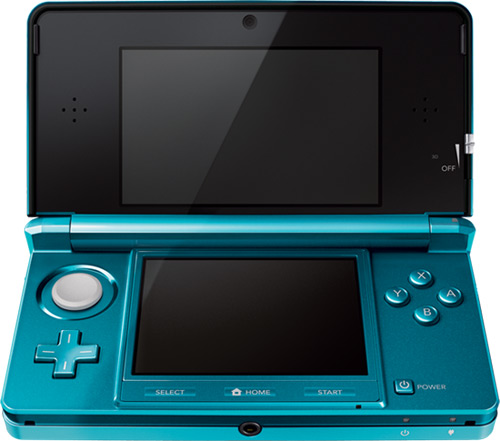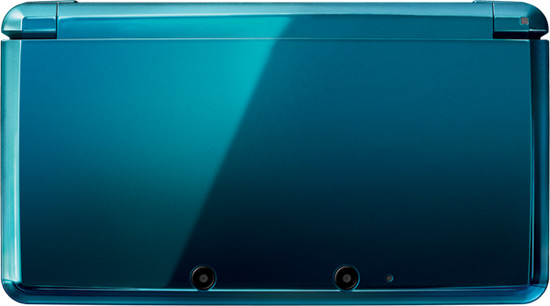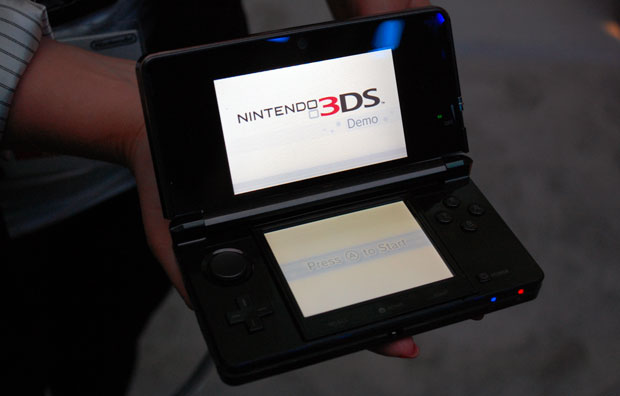
You forget about some of the fun stuff you’ve seen after having spent an entire week fighting crowds in Las Vegas while sick and tired. And I do mean sick and tired: I was sick flying into Las Vegas (you know the sharp, stabbing pain you get in your ears when your airplane descends from the heavens while sick? Yeah, I had that, and it wasn’t fun), and all that running around, lugging cameras and other equipment all over the place had me exhausted by the end of the first day. But I persevere to bring you our impressions of the Nintendo 3DS. Yes, in one of the fancy hotels away from the din of the show floor Nintendo met with John and I for a while to give us some one-on-one time with the system. Needless to say we both walked away thinking, “Yeah, that’s a decent little machine right there.” But how decent? Hmm.
The first game we played was a demo build of Pilotwings Resort. Now, I’m one of those people who managed to get all gold medals in Pilotwings 64 (I didn’t play the original SNES version), so at the very least I was familiar with the game going in. That’s handy for our purposes because it wasn’t a case of me being new to both the hardware and the software; I only had to fight one battle.
But let’s start with the hardware. As I’m sure you’ve read elsewhere, the 3DS is about halfway between the size of the DSi and the DSi XL. If you thought the DSi XL was too big, or perhaps thought the DSi was too small, well, there you go: it’s a happy medium between the two.
The only addition, input-wise, is what Nintendo calls the CirclePad. It’s the small nub on the top-left hand corner of the system that you use much as you’d use the N64 ControlStick: the D-Pad is there, but unless the game really lends itself to D-Pad control you’ll be using the CirclePad. I guess the only thing I could compare it to is the nub found on the PSP, but it’s not as pointless as the PSP’s first gen nub. (I’d say the PSP Go‘s nub just about gets the job done.) I don’t think you’ll be fighting against the CirclePad, is what I mean to say.

On the right side of the top screen is a small dimmer switch-like lever that controls the system’s 3D effect. You can leave it turned up to the max, down to zero, or anywhere in between. Nintendo explained it by saying that not every game will truly benefit from 3D, so they’re giving users the options to turn it off. There’s nothing wrong with choice. So let’s say you’re playing Zelda and, for whatever reason, you want to totally turn off the 3D effect. You can. Or maybe you want it on full-bore. You can. Or, yes, somewhere in between: your choice.
But how does the 3D effect look? It certainly looks as good as any 3DTV I’ve ever seen, and I’ve seen entirely too many of them over the past year or so. How does it compare to something like Avatar? Here’s a secret: have you ever wondered why every single 3DTV advertisement points to Avatar as if that’s the only movie that exists? That’s because it’s still the only example of a movie that fully takes advantage of 3D. It’s a new medium, 3D (well, not really, but this particular incarnation is new), and not too many people have fully figured it out yet (lest we forget that James Cameron is an Academy Award-winning director). My feeling is that 3D will really blossom with video games. So while I don’t want to sound over-the-top and say something as silly as “It looks just like Avatar!” it’s definitely on par with any of 3DTVs you can find out there.
On to the games.
We played two games: the aforementioned Pilotwings, and we also played some sort of augmented reality game.
Pilotwings is the Pilotwings we all remember from the N64, but better! It truly is, and that’s 100 percent because of 3D. You control your character with the CirclePad, using it to move side to side and forward and back; A accelerates and B brakes (those could be reversed, mind). The demo we played had us in that mode where, in a jetpack, you smash through balloons that are dotted all over the map. And yes, as you move about the map, and as you smash through the balloons, you definitely get the “OK, this is a 3D game I’m playing here” sensation. Since the game has you constantly calculating depth and angles and so forth, 3D here is a genuine gameplay benefit, and not merely a fun gimmick. (Not that there’s anything wrong, per se, with fun gimmicks.) I can’t be sure if that will always be the case with 3DS games, but it is with this one.
 Sick of this photo yet?
Sick of this photo yet?
There was another game we played that taps into the whole augmented reality… craze, I guess you can call it. (I just felt like Grandpa Simpson right there.) What we did was point the 3DS’ back-facing camera at the edge of a table. You leave it pointed there for a second and, in our case, up popped a monster on the screen! You’re then to shoot the monster much like you would any SNES-era boss. Shoot him enough times and you win. Simple as that. The “level” all of this takes place in is the same ledge (or whatever) you pointed at. Reality (here, the ledge) is the “level” and the augmentation is the fact that you’re shooting at a monster that’s not really there. Of course you can move the 3DS about in order to avoid getting hit by the monster (its projectiles come at you with the full 3D effect, as you might expect) so it’s not a static experience by any means.
It’s worth pointing out that Nintendo is expected to give the full North American launch details next week in New York, and barring some bizarre turn of events we should be there. (The Japanese launch details were revealed yesterday.) Something to look forward to, then.